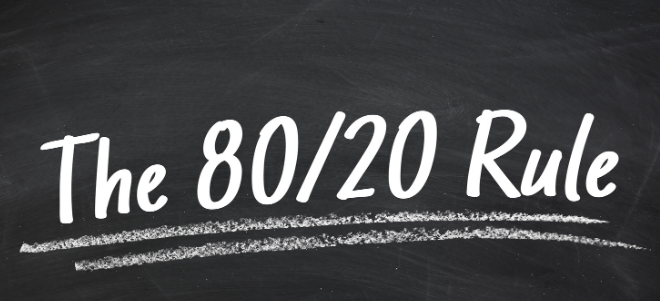For running what does the 80/20 rule means?
In a week, run 80% of your training runs at a slow and easy conversational pace, and the remaining 20% of your training volume at a hard effort or high intensity.
Your easy days need to be easy, and your hard days need to be hard.
The primary purpose of the 80/20 method in running is to ensure that your body is recovering on your recovery days so that you are able to maximize your effort and performance on the hard days.
The follower of this rule reduces the risk of overtraining and overuse injuries because your muscle tissues recover during the easy runs and are ready for the hard run. This rule applies to every runner but is more true for aging runners, who are more prone to injuries and whose recovery time is longer respective to younger athletes.
Benefits of the 80/20 method of running include the following:

#1: Running Slow Improves the Efficiency Of the Aerobic System
Running slowly keeps your heart rate in the aerobic zone, which means that you are taking in enough oxygen through your respiratory system to meet the oxygen demands of your working muscles.
Both fat and glycogen (stored carbohydrates) can be broken down to create energy through aerobic metabolism. The benefit of generating energy through aerobic pathways is that the metabolic byproducts do not “pollute” your muscles or cause fatigue.
This is in contrast to what occurs with anaerobic glycolysis, an energy-generating metabolic pathway that occurs when your muscles aren’t getting enough oxygen.
All runners must pay very close attention to their heart rates. It is a very important factor in how long and how fast you will run. If the heart rate goes up, meaning your heart is pumping faster to meet your oxygen demand at that pace. A faster heart rate leads to a decrease in efficiency, tiredness, and slowing down. When you are running tired, you will make mistakes, and cause injuries.
Running slowly improves the efficiency of your aerobic system due to adaptations such as increases in capillary densities in your muscles, increases in the strength and chamber size of your heart muscle, and increases in blood plasma volume.
As a result of these adaptations to aerobic training, your heart and lungs are better able to take in and circulate more oxygen at higher workloads, and your muscles and tissues are able to extract and use the oxygen to generate energy aerobically.
The more efficient your aerobic system becomes, the faster and longer you can run without getting winded or needing to produce a significant percentage of energy from exhaustive anaerobic metabolism.
#2: Running Slow Reduces the Risk of Injury
When you run slower, there is less strain on your muscles and connective tissues and less stress on your bones and joints. The ground reaction force decreases at slower speeds, and your stride length shortens. These changes decrease the risk of injuries.
#3: Running Slow Reduces the Risk of Overtraining and Allows You to Actually Run Fast
Runners who run their long runs and easy runs too hard are always flirting with the risk of overtraining because the accumulated fatigue drives the stress up in the body.
If you’ve only recovered to 80-85%, when it’s time to do the next hard speed workout, your body will already be starting at a reduced capacity–you only have 80-85% of your effort to give to the workout, instead of nearly 100%.
This means your ability to run as hard or as fast during the workout is impaired, which impedes your potential performance gains.
In practical terms, if you’re supposed to run fast 6 x 1,000 at your 10k pace, but you’re only able to muster about 5 reps, or you are falling 5 seconds off your pace for each interval, your body will not have as potent of a training stimulus for inducing positive fitness adaptations.
By running your easy runs easily, you will actually have the strength and energy to maximize your hard workouts and nail the times you are striving for
#4: Running Slow Helps Your Body Become More Efficient at Burning Fat
Slow running causes favorable adaptations in fat metabolism, allowing you to run faster while still burning fat for fuel rather than carbohydrates.
At lower intensities of exercise, the muscles are able to burn fat to generate ATP (cellular energy) rather than rely more heavily on stored glycogen (carbohydrates). Our bodies have a limited capacity to store carbohydrates in the form of glycogen, whereas even the leanest runners have enough body fat to fuel hours upon hours of exercise.
Running slowly helps your body get better at burning fat and sparing glycogen, which can be hugely beneficial for marathoners as well as those looking to burn body fat.
How To Do The 80/20 Method of Running
Again, the 80/20 method of running involves running easy for 80% of your mileage or minutes (depending on your preferred style of workout accounting) and running hard for the other 20% of your mileage or minutes.
For example, if you run 30 miles per week (about 50 km), you will run 24 miles at an easy pace or easy effort, and 6 miles will be devoted to speed work.
Of course, it might not always be as simple as saying if you run 5 days a week, you should run 4 days easy and one day hard, as you may run a different number of days per week where the math isn’t as neat.
Moreover, even if you run five days a week, you might have two hard workouts, but the mileage accrued during warm-ups, cool-downs, and recoveries counts on the “easy” side of the 80/20 rule, not the “hard” side.
So, if your workout is 2 miles warm-up, 3 x 1 mile at 5k pace with 400m in between, and a 1-mile cooldown, you’ve run 3.75 miles easy and 3 miles hard.
How Slow Should Your Easy Runs Be?
How to calculate the personal slow pace.
The best method is to slow down twenty additional percent from your age-appropriate maximum heart rate.
Calculating individual Theoretical Maximum Heart Rate
For example, for a 62-year-old runner the Max heart rate is
Max heart rate=220 – 62(age) = 158 beats per minute
Calculating Your Theoretical Maximum slow run Heart Rate
The target heart rate is 20% slower than the Max heart rate
Target heart rate = 158 – 31.6 = 126.4
20% slower than the Target heart rate
Slow Run Pace = 126.4 – 25.3 = 101.1
If it is too slow, then pick 10% slower = 126.4 – 12.6 = 113.8
In nutshell, a slow run for a 62-year-old can be between 114 to 127 bpm (Beats per minute)
Reference docs:

